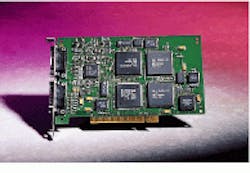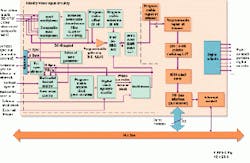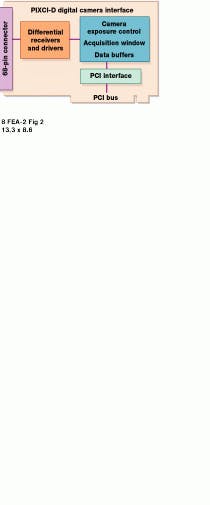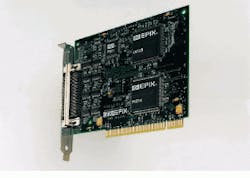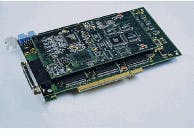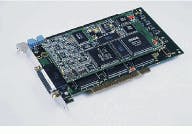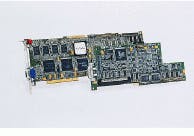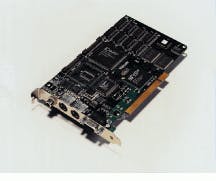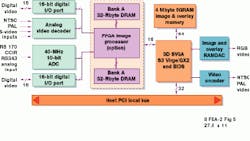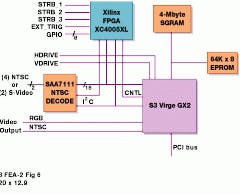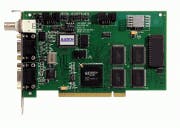CHOOSING A PCI-BASED frame grabber FOR VISION APPLICATIONS
CHOOSING A PCI-BASED frame grabber FOR VISION APPLICATIONS
By Andrew Wilson, Editor at Large
Picking a PC-based frame-grabber board for an image-processing system has never been easier--or more difficult. Indeed, boards ranging from low-cost RS-170 converters to sophisticated image-capture, storage, and processing products are available from more than 50 vendors. These boards offer a range of analog and digital camera interfaces, dedicated or programmable image-processing hardware, VGA and higher display resolutions, and software support.
Because available options vary widely, systems integrators must focus on developing a concrete definition of what the end-user system must perform. Based on that premise, they can aptly choose the correct frame grabber with the optimum price/performance ratio. Systems integrators must also ensure that the software developed around the selected frame grabber can be easily upgraded should system performance requirements change. Accordingly, system input standards, processing capabilities, and display modularity also play important roles.
Standard inputs
Many monochrome frame-grabber boards accommodate analog RS-170 or CCIR video inputs, while color frame-grabber boards have adopted the NTSC, PAL, or S-VHS standards. To digitize video images, frame grabbers sample analog video at uniform intervals on each video line to measure the gray-scale level of each pixel. Unfortunately, the frame grabber can never precisely adjust the sampling points relative to the horizontal sync pulse, resulting in pixel jitter.
"Pixels are sampled about every 80 ns in an image with 640 pixels per line," says Gail Marshall of Imagenation (Beaverton, OR). In well-designed frame grabbers with a jitter specification of ۯ ns, the pixel positional error equates to 12.5%. "Near an edge, the brightness of an image can change from zero to maximum in one pixel period," declares Marshall, "so when measuring a video waveform with such high slopes, a positional error of 12% will translate to a similar 12% error in brightness measurement."
To overcome the pixel-jitter problem, advanced frame grabbers incorporate timing generators that allow the system camera to be driven from the board itself. Because no on-board phase-lock loop (PLL) is used, pixel jitter is eliminated. For example, in the design of its DT3152 monochrome PCI frame grabber, Data Translation (Marlboro, MA) specifies a ۮ-ns pixel jitter (see Fig. 1). With an on-board 1-kHz to 20-MHz programmable clock, this board also allows a camera`s pixel clock to control image acquisition.
Because of intensified user demands, machine-vision systems designers are stipulating more sophisticated camera inputs that include digital linescan, time-delay integration (TDI), and large format area-array imagers. To meet these needs, several vendors have developed specialized digital camera interface boards based around the PCI bus. Similar to their analog counterparts, many digital interface boards can be synchronized to the camera`s pixel clock to eliminate jitter.
In such designs, on-board programmable gate arrays are often used to dynamically configure such boards for interfacing to different types of digital cameras. Typical of these boards is the PIXCI-D from Epix (Buffalo Grove, IL; see Fig. 2). Factory programmed to interface to such cameras as the CA-D series from Dalsa (Waterloo, Ontario, Canada), the A113 series from Basler (Ahrensburg, Germany), and the ES Series from Kodak (San Diego, CA), the PIXCI-D can be programmed to synchronize to the camera`s pixel clock.
No memory required
Once digitized, many frame grabbers use on-board look-up tables (LUTs) to perform image preprocessing. These tables are especially useful in applications that require real-time thresholding, allowing, for example, objects in an image to be more readily identified.
While older EISA-bus frame grabbers provided such preprocessing functions as standard, recent PCI offerings have relegated such processing--and sometimes all image-processing functions--to the host PC. In such low-cost frame-grabber designs, vendors are taking advantage of the speeds of the PCI bus and host CPUs to lower the cost of imaging peripherals.
"With the advent of the PCI bus," says Scott Israel, vice president, sales and marketing, of Imaging Technology (Bedford, MA), "it is possible to transfer RS-170 video from a video camera at a rate of 10 Mbytes/s, which is well within the capacity of the PCI bus."
With a peak transfer rate of 132 Mbyte/s, the PCI bus is fast enough to support image transfers into host PC memory at frame rates. To support such transfers, manufacturers currently supply frame grabbers in a variety of architectures that can support bus-mastering capability and that come with first-in first-out (FIFO) based or on-board memory. In straightforward image-processing applications, where real-time data capture is relatively unimportant, the system central processing unit (CPU) can be used to control image acquisition. To off-load address generation from the CPU, however, most PCI frame grabbers support bus mastering, where the frame grabber makes the required requests for memory transfers, leaving the CPU free for other processing tasks.
Another important consideration in choosing a PCI frame grabber is whether FIFO or on-board memory is required. Once again, this choice is application-dependent. "For standard video," says Kevin Sullivan, Data Translation vice president of engineering, "1024 bytes of FIFO provides enough of a buffer to cover a latency of 63.5 ms (the time required to capture a line of RS-170 video). And because the bus is so fast, especially during data bursting, latencies do not build up."
"With FIFO technology, you have to transfer one line at a time," says Gary Wagner, president of Imaging Technology. "For RS-170, that means you are sending 480 lines over 33 ms. FIFO-based designs require the use of the Intel motherboard PCI controller and the CPU to manage it," he adds. Measurements made at Imaging Technology show that a 42% CPU involvement is required during the 33-ms transfer. However, for frame grabbers with on-board memory, the transfer only requires a 1% involvement, thus minimizing CPU and bus usage and allowing them to perform other system control functions.
"In addition," says Wagner, "it is a known fact that in using FIFO technology you will eventually miss a line of video once every so many frames. While this can be tolerated for multimedia, losing one line of video in a machine-vision application will certainly affect any analysis of the image" (see "PCI-bus lockout challenges vision system integrators," p. 12).
In the design of its half-slot ICI-PCI frame grabbers (see Fig. 3), Imaging Technology incorporates up to 4 Mbytes of on-board memory for buffering image data between the camera and the host PC. This memory allows the IC-PCI board to simultaneously acquire and process data and assures that image information is not lost during the transfer to system memory.
On-board processing
In addition to making digitizing and memory choices, systems integrators must choose whether their application requires on-board processing. In the past, the ISA bus, with its 16-bit data path and 8-MHz clock speed, mandated the use of on-board FIFOs, memory, LUTs, and digital-signal processors (DSPs). Now, with the advent of the PCI bus, manufacturers are looking to expand the capabilities of frame-grabber products.
For example, Matrox (Dorval, Quebec, Canada) used the modular-design approach taken with its C80-based Genesis PCI board to tailor a low-cost alternative for applications that do not require the additional power of the C80 processor. Dubbed the Genesis-LC, this PCI board can be interfaced to a variety of analog and digital cameras. It also offers on-board LUT processing, up to 6 Mbytes of on-board memory, and integrated display output for driving resolutions as high as 1600 ¥ 1200 pixels (see Fig. 4).
Although many frame-grabber vendors offer modular image capture, processing, and display boards, others are reducing costs by tailoring products to meet more application-specific requirements. "For example," says Eli Warsawski, general manager of the imaging-products division of Visicom (San Diego, CA), "a number of medical applications require rotational correction on a frame-by-frame basis. This capability is far superior over mechanical methods to correctly orientate and stabilize live camera images such as those used in image-guided surgery and endoscopy. In these applications, bilinear interpolated rotation is used to maintain both accuracy of detail and the 30-frame/s image orientation."
To perform such functions, Visicom`s VigraVision PCI board uses Xilinx Series 4000 programmable gate arrays, according toWarsawski. These provide a flexible, high-performance lower-cost alternative to general-purpose DSPs (see Fig. 5).
Like Visicom, Aspro Technologies (Mississauga, Ontario, Canada) is also looking to fill a specific market niche. In the design of its Invader-32 frame grabber, the company has incorporated a Zoran Motion JPEG chip set for on-board image compression and decompression. Capable of digitizing standard HTSC, SECAM, and YUV data, this PCI-board also provides scaleable video-in-a-window functionality.
VGA displays
Just as choosing a board with either LUT or on-board memory is application-dependent, so too is the purchase of a frame-grabber board with an on-board display capability. Frame-grabber boards that provide no on-board display capability transfer images across the PCI bus to the system VGA card, where the live video is displayed in a window on the system monitor.
Although this approach results in increased bus traffic, it does reduces the cost of the frame-grabber board. Until recently, this data-transfer method resulted in destructive overlays, as video and overlaid information resided in the same area of memory. "Now," says Fernando Serra, marketing development manager at Imaging Technology, "newer VGA chips parse the memory on the VGA card into two parts, the primary and secondary surfaces, that are mixed together by the VGA chip for display. And because these surfaces are individually addressable, developers can use frame grabbers such as Imaging Technology`s IC-PCI in conjunction with certain VGA cards to provide nondestructive overlay capability."
While some frame-grabber manufacturers use the system`s host VGA graphics controller to display images, others off-load the PCI bus from image data transfers by incorporating graphics display on-board. Such integrated frame grabber/processor/display controller cards use programmable gate arrays to control camera input and, in the case of Visicom`s VigraVision PCI board, for image processing.
Many frame-grabber designs, including the VigraVision, use the Virge graphics controller from S3 Inc. (Santa Clara, CA) as a means of displaying 1280 ¥ 1024-resolution images at 72 Hz noninterlaced. Better still, because the graphics chip generates red-green-blue (RGB) or separate NTSC or PAL video output signals, users can monitor images that have been targeted for acquisition on a separate display.
Visicom isn`t the only company to embrace the S3 chip. Alacron (Nashua, NH) has introduced an FG-A-PCI analog color frame grabber for the PCI bus (see Fig. 6). This frame-grabber board can capture RS-170-, NTSC-, or PAL-formatted video and act as a bus master to transfer S-Video images to host PC memory at 100 Mbyte/s. Unlike the Visicom board, however, Alacron engineers have not implemented field-programmable gate array image-processing capability on the FG-A-PCI board.
Despite the importance of choosing the correct frame grabber, systems integrators are also faced with the problem of matching graphics controllers and other peripherals on the PCI bus. If, for example, several additional PCI boards are needed in a single-chassis imaging system, bus bandwidth may dictate the choice of a frame-grabber board. If high-speed, high-throughput image processing is required, FIFO-based image-capture boards, even with MMX-tailored software, may not be fast enough; therefore, a pipelined-based solution may be needed (see "Parallel processing tackles tough imaging tasks" on p. 52). By understanding such design factors, the systems integrators` choice of which frame grabber to choose is often imposed by the overall system requirements.
FIGURE 1. Because it operates as a bus master, the DT3152 monochrome PCI frame grabber board from Data Translation can transfer images continuously to the system monitor or host memory for storage.
FIGURE 2. The PIXCI-D board from Epix is a PCI board that can be factory programmed to interface to a range of digital-line or area-array cameras, including EG&G`s LD-2010, Pulnix`s TM-1001, and Silicon Mountain Design`s 4M4.
FIGURE 3. Imaging Technology`s ICI-PCI family of frame grabbers consists of seven boards that include IC-COMP, an image-capture board for standard composite cameras, IC-RGB for RGB color and variable scan cameras, and IC-DIG for digital-line and area-scan cameras
FIGURE 4. The Matrox Genesis-LC board was developed as a low-cost alternative to the company`s C80-based family of vision processors. As a full-size, single-slot PCI frame grabber, the board interfaces to standard and non-standard video sources and provides an on-board 1600 x 1200-pixel display capability.
FIGURE 5. The Visicom VigraVision PCI board combines a color frame grabber, an accelerated SVGA display controller, and real-time image processing. On-board reconfigurable image processing is provided by a Xilinx Series 4000 FPGA.
FIGURE 6. Combining a color frame grabber and an accelerated SVGA display, the Alacron FG-A-PCI analog board for the PCI bus can capture standard RS-170, NTSC, PAL, or S-Video signals.
